Справка по макету Android, недостающие элементы
Я пытаюсь создать макет, который содержит "SurfaceView" вверху с горизонтальной панелью инструментов, которая разделена на 3 сегмента в нижней части, однако мой SurfaceView, который содержит предварительный просмотр камеры, является единственным отображаемым элементом. Пожалуйста, укажите на ошибку в моем макете XML или предоставьте мне похожий макет XML, спасибо.
Ниже мой макет и обновления на основе рекомендаций пользователя
Попытка № 1 (RelativeLayout от имени root):
<RelativeLayout xmlns:android="http://schemas.android.com/apk/res/android"
android:id="@+id/LayoutForPreview"
android:layout_width="fill_parent"
android:layout_height="fill_parent"
android:orientation="vertical"
android:screenOrientation="portrait" >
<SurfaceView
android:id="@+id/surfaceViewBarcodeScanner"
android:layout_width="match_parent"
android:layout_height="wrap_content"
android:layout_above="@+id/linearLayoutToolbar"
android:layout_gravity="top"
android:scaleType="fitXY" />
<LinearLayout
android:id="@+id/linearLayoutToolbar"
android:layout_width="match_parent"
android:layout_height="wrap_content"
android:layout_alignParentBottom="true"
android:orientation="horizontal" >
<ImageView
android:id="@+id/imageView1"
android:layout_width="wrap_content"
android:layout_height="wrap_content"
android:scaleType="fitXY"
android:src="@drawable/scanner_bottom_left" />
<ImageView
android:id="@+id/imageView2"
android:layout_width="wrap_content"
android:layout_height="wrap_content"
android:layout_weight="0.68"
android:scaleType="fitXY"
android:src="@drawable/scanner_bottom_center_toolbar" />
<ImageView
android:id="@+id/imageView3"
android:layout_width="wrap_content"
android:layout_height="wrap_content"
android:scaleType="fitXY"
android:src="@drawable/scanner_bottom_right_landscape_button" />
</LinearLayout>
</RelativeLayout>
Ниже мой желаемый внешний вид GUI:
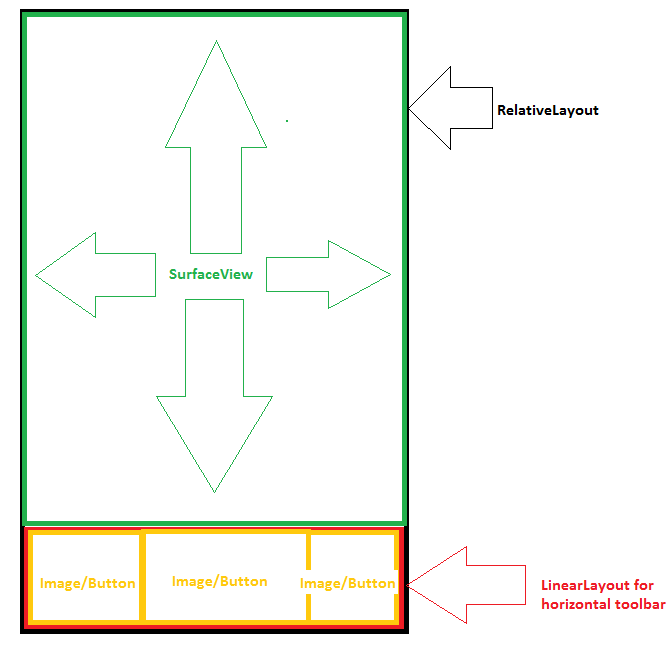
Попытка # 1 Результат, снимок устройства, который показывает только SurfaceView:
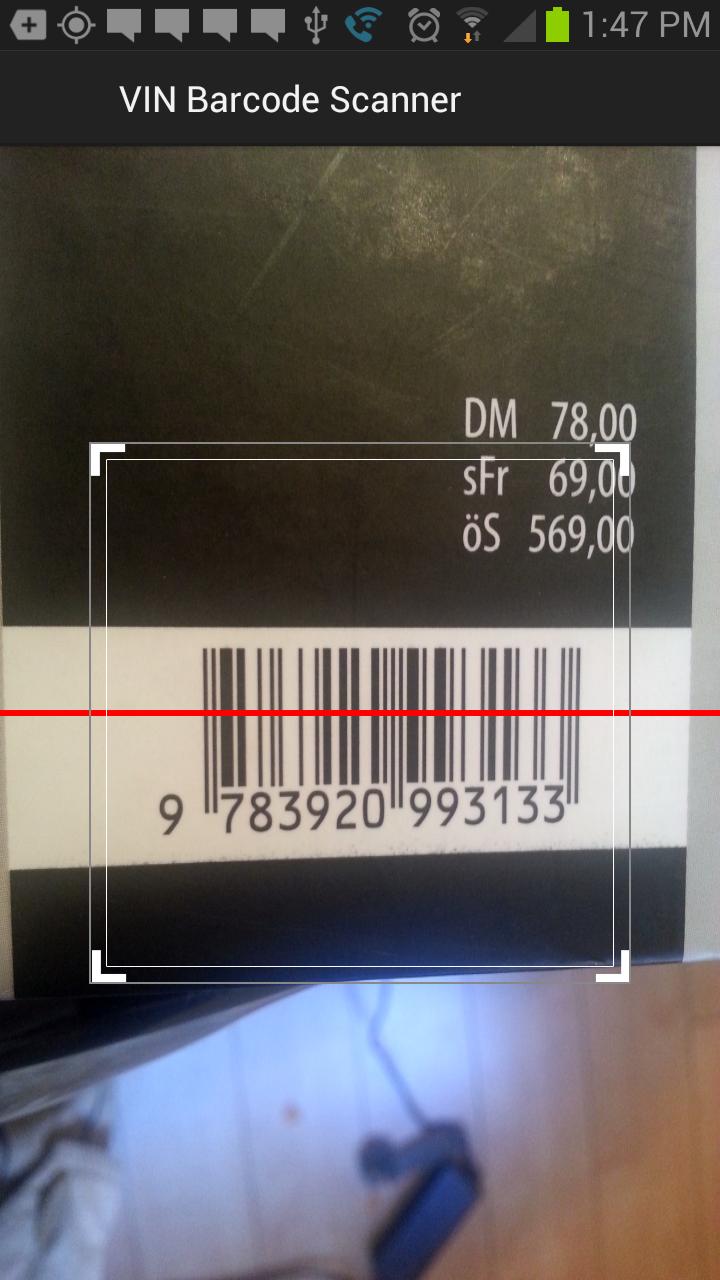
Снимок графического инструмента eclipse, который показывает, как должен выглядеть макет. 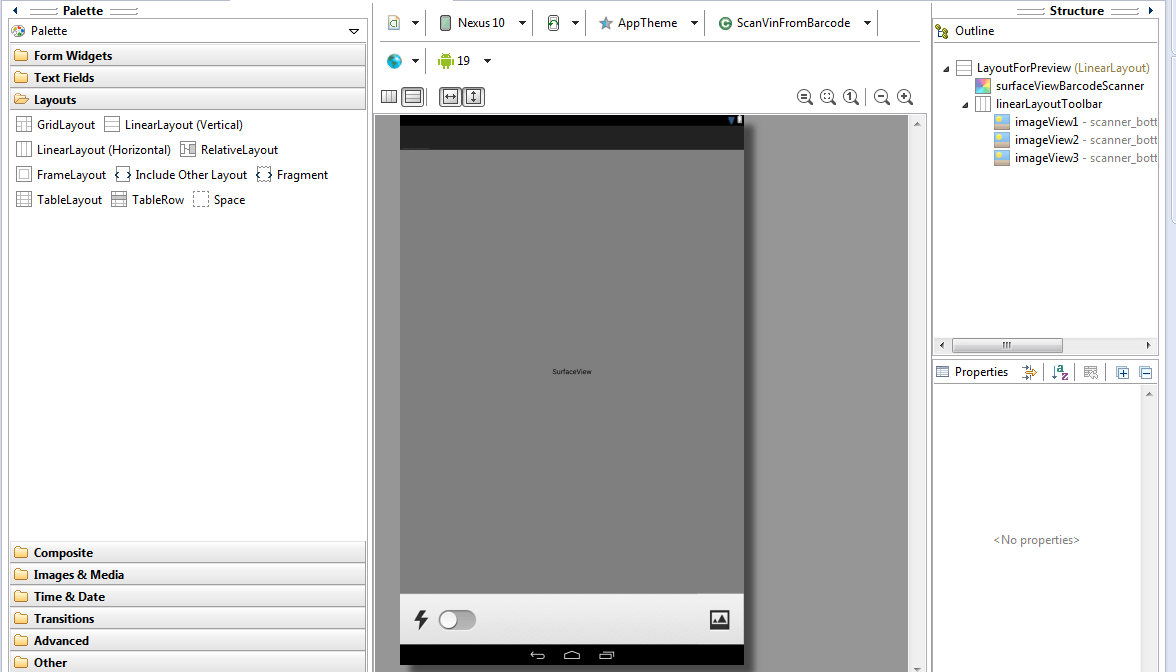
Попытка № 2 (LinearLayout как root):
<LinearLayout xmlns:android="http://schemas.android.com/apk/res/android"
android:id="@+id/LayoutForPreview"
android:layout_width="fill_parent"
android:layout_height="fill_parent"
android:orientation="vertical"
android:screenOrientation="portrait" >
<SurfaceView
android:id="@+id/surfaceViewBarcodeScanner"
android:layout_width="match_parent"
android:layout_height="wrap_content"
android:layout_gravity="top"
android:scaleType="fitXY"
android:layout_weight="1" />
<LinearLayout
android:id="@+id/linearLayoutToolbar"
android:layout_width="match_parent"
android:layout_height="wrap_content"
android:orientation="horizontal"
android:layout_gravity="bottom" >
<ImageView
android:id="@+id/imageView1"
android:layout_width="wrap_content"
android:layout_height="wrap_content"
android:scaleType="fitXY"
android:src="@drawable/scanner_bottom_left" />
<ImageView
android:id="@+id/imageView2"
android:layout_width="wrap_content"
android:layout_height="wrap_content"
android:layout_weight="0.68"
android:scaleType="fitXY"
android:src="@drawable/scanner_bottom_center_toolbar" />
<ImageView
android:id="@+id/imageView3"
android:layout_width="wrap_content"
android:layout_height="wrap_content"
android:scaleType="fitXY"
android:src="@drawable/scanner_bottom_right_landscape_button" />
</LinearLayout>
</LinearLayout>
Попытка № 2, Результат, Снимок устройства:
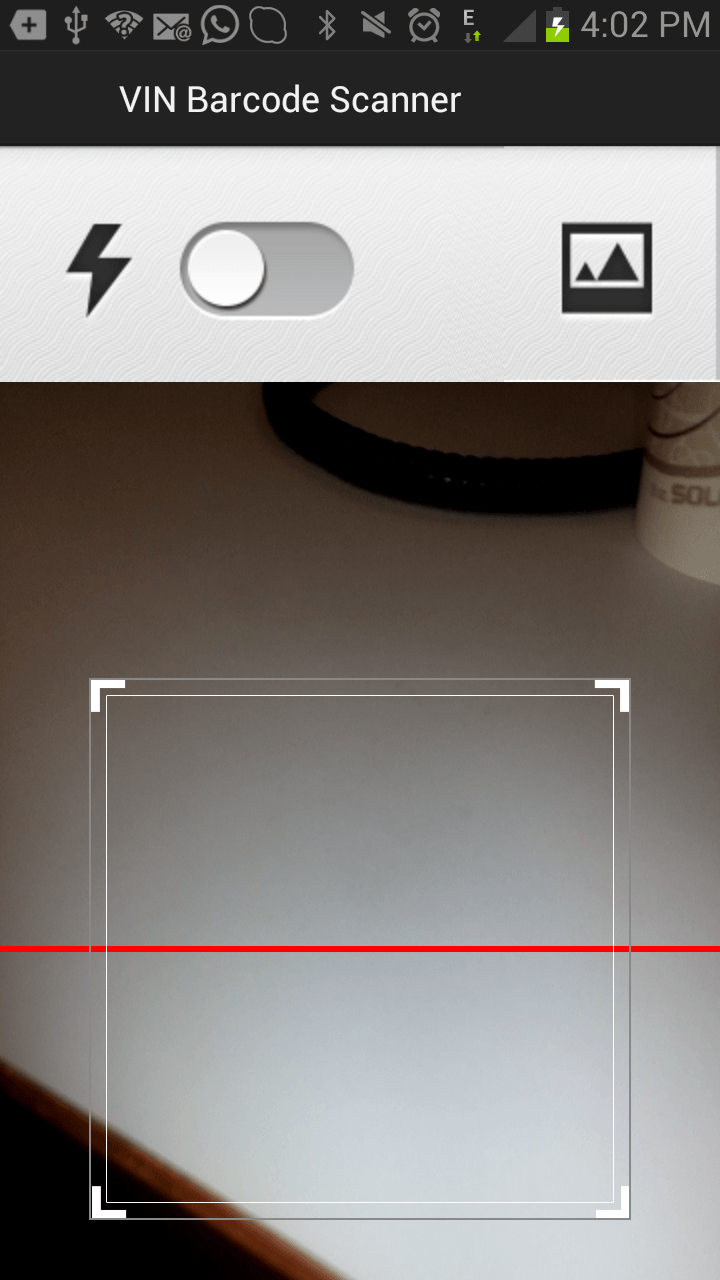
Вопросы:
1) Панель инструментов появляется сверху, а не снизу
2) Предварительный просмотр камеры зависает и приложение вылетает. По какой-то причине LinearLayout вызывает ошибку камеры 1001, и я думаю, что это связано с размерами предварительного просмотра.
Попытка № 3 (программно добавить панель инструментов в относительный или линейный макет в действии onCreate).
LinearLayout:
<LinearLayout xmlns:android="http://schemas.android.com/apk/res/android"
android:id="@+id/LayoutForPreview"
android:layout_width="fill_parent"
android:layout_height="fill_parent"
android:orientation="vertical"
android:screenOrientation="portrait" >
<SurfaceView
android:id="@+id/surfaceViewBarcodeScanner"
android:layout_width="match_parent"
android:layout_height="wrap_content"
android:layout_gravity="top"
android:scaleType="fitXY"
android:layout_weight="1" />
</LinearLayout>
Панель инструментов определена в отдельном XML, добавленном позже через код Java:
<?xml version="1.0" encoding="UTF-8"?>
<!-- LinearLayout that contains toolbar that is divided into 3 sections horizontally , layout_below="@+id/BarcodeScannerFrame-->
<LinearLayout
xmlns:android="http://schemas.android.com/apk/res/android"
android:id="@+id/linearLayoutToolbar"
android:layout_width="match_parent"
android:layout_height="wrap_content"
android:layout_gravity="bottom"
android:orientation="horizontal" >
<ImageView
android:id="@+id/imageView1"
android:layout_width="wrap_content"
android:layout_height="wrap_content"
android:scaleType="fitXY"
android:src="@drawable/scanner_bottom_left" />
<ImageView
android:id="@+id/imageView2"
android:layout_width="wrap_content"
android:layout_height="wrap_content"
android:layout_weight="0.68"
android:scaleType="fitXY"
android:src="@drawable/scanner_bottom_center_toolbar" />
<ImageView
android:id="@+id/imageView3"
android:layout_width="wrap_content"
android:layout_height="wrap_content"
android:scaleType="fitXY"
android:src="@drawable/scanner_bottom_right_landscape_button" />
</LinearLayout>
onCreate, onResume, другие соответствующие фрагменты кода только для моей деятельности, панель инструментов LinearLayout добавляется в линейный или относительный макет во время выполнения:
//import not included
public class ScanVinFromBarcodeActivity extends Activity {
// camera object that is used globally in this activity and also passed
// reference to PreviewSurface inner class
private Camera globalCamera;
private int cameraId = 0;
// bitmap that would created after picture is taken and converted from
// camera bytes
private Bitmap bmpOfTheImageFromCamera = null;
// global flag whether a camera has been detected
private boolean isThereACamera = false;
// layout for this activity
private LinearLayout RelativeLayoutBarcodeScanner= null;
// CameraPreview extends SurfaceView displays preview of images from the
// Camera
private CameraPreview newCameraPreview = null;
// used to inflate the xml layout
private SurfaceView surfaceViewBarcodeScanner = null;
private boolean cameraPreviewing = false;
// this continueToAutomaticallyDecode flag is initially set to TRUE, but
// will be set to FALSE on the first successful decode OR when a crucial
// method in the code process fails or throws an exception
private volatile boolean continueToAutomaticallyDecode = true;
// global flag used to indicate picture taking & decoding is in progress
private volatile boolean takingPictureAndDecodeInprogress = false;
// Bitmap options for bitmap creation from camera picture
BitmapFactory.Options options = null;
// used for samsung galaxy s devices only
private Matrix rotationMatrix90CounterClockWise = null;
// Reader is class from zxing used to decode barcodes
Reader reader = null;
// DecodeHintType hashtable is used to provide help to the zxing Reader
// class
Hashtable<DecodeHintType, Object> decodeHints = null;
//
private boolean onTouchEvent = true;
//
private OrientationEventListener orientationEventListener = null;
// 1 means the screen is PORTRAIT and 2 means screen is LANDSCAPE
private int latestScreenOrientation = 1;
//
Camera.Parameters Flash = null;
//
private String globalVIN = null;
//
private Handler handler = null;
//
private LinearLayout barcodeVinScannerToolbar = null;
public boolean isContinueToAutomaticallyDecode() {
return continueToAutomaticallyDecode;
}
public void setContinueToAutomaticallyDecode(
boolean continueToAutomaticallyDecode) {
this.continueToAutomaticallyDecode = continueToAutomaticallyDecode;
}
public boolean isTakingPictureAndDecodeInprogress() {
return takingPictureAndDecodeInprogress;
}
public void setTakingPictureAndDecodeInprogress(
boolean takingPictureAndDecodeInprogress) {
this.takingPictureAndDecodeInprogress = takingPictureAndDecodeInprogress;
}
/*
* This method , finds FEATURE_CAMERA, opens the camera, set parameters ,
* add CameraPreview to layout, set camera surface holder, start preview
*/
@SuppressLint("InlinedApi")
private void initializeGlobalCamera() {
try {
if (!getPackageManager().hasSystemFeature(
PackageManager.FEATURE_CAMERA)) {
Toast.makeText(this, "No camera on this device",
Toast.LENGTH_LONG).show();
} else { // check for front camera ,and get the ID
cameraId = findFrontFacingCamera();
if (cameraId < 0) {
Toast.makeText(this, "No front facing camera found.",
Toast.LENGTH_LONG).show();
} else {
Log.d("ClassScanViewBarcodeActivity",
"camera was found , ID: " + cameraId);
// camera was found , set global camera flag to true
isThereACamera = true;
// OPEN
globalCamera = getGlobalCamera(cameraId);
// parameters auto focus
globalCamera.getParameters().setFocusMode(
Camera.Parameters.FOCUS_MODE_CONTINUOUS_PICTURE);
// set picture format to JPEG, everytime makesure JPEg
globalCamera.getParameters().setPictureFormat(
ImageFormat.JPEG);
autoFocusSetupForBarcode(globalCamera);
/*
* START early setup variables & setting used in
* jpegCallback in order to optimize the jpegCallback code
*/
options = new BitmapFactory.Options();
// option set for down sampling he captured image taken from
// the camera in order to MemoryOutOfBounds exception
options.inSampleSize = 4;
// image quality rather than speed in order to achieve early
// barcode detection & decode
options.inPreferQualityOverSpeed = false;
// Samsung galaxy S only , rotate to correct orientation
// ,and capture only the image within the guidance rectangle
rotationMatrix90CounterClockWise = new Matrix();
rotationMatrix90CounterClockWise.postRotate(90);
// early variable used by zxing to decode method
decodeHints = new Hashtable<DecodeHintType, Object>();
decodeHints.put(DecodeHintType.TRY_HARDER, Boolean.TRUE);
decodeHints.put(DecodeHintType.PURE_BARCODE, Boolean.TRUE);
decodeHints.put(DecodeHintType.ASSUME_CODE_39_CHECK_DIGIT,
Boolean.TRUE);
reader = new MultiFormatReader();
turnOnFlashlight(globalCamera);
// pass surfaceView to CameraPreview
newCameraPreview = new CameraPreview(this, globalCamera) {
@Override
public boolean onTouchEvent(MotionEvent event) {
Log.d("ClassScanViewBarcodeActivity",
" onTouchEvent(MotionEvent event) ");
onTouchEvent = true;
globalCamera
.autoFocus(autoFocusCallbackForAutomaticScan);
return super.onTouchEvent(event);
}
};
// pass CameraPreview to Layout
RelativeLayoutBarcodeScanner.addView(newCameraPreview);
// give reference SurfaceView to camera object
globalCamera.setPreviewDisplay(surfaceViewBarcodeScanner
.getHolder());
// PREVIEW
if (cameraPreviewing != true) {
globalCamera.startPreview();
}
Log.d("ClassScanViewBarcodeActivity",
"camera opened & previewing");
}
}// end else ,check for front camera
}// end try
catch (Exception exc) {
// in case of exception release resources & cleanup
if (globalCamera != null) {
globalCamera.stopPreview();
cameraPreviewing = false;
globalCamera.setPreviewCallback(null);
globalCamera.release();
globalCamera = null;
options = null;
rotationMatrix90CounterClockWise = null;
reader = null;
}
Log.d("ClassScanViewBarcodeActivity initializeGlobalCamera() exception:",
exc.getMessage());
exc.printStackTrace();
}// end catch
}// end ini
/* this method detect whether the camera flashlight a.k.a torch feature is available to be turned on then turns on the light*/
public void turnOnFlashlight(Camera camera) {
Log.d("ClassScanViewBarcodeActivity",
"turnOnFlashlight(Camera camera )");
boolean flag = false;
Context context = null;
if (camera != null) {
Log.d("ClassScanViewBarcodeActivity",
"turnOnFlashlight() , FEATURE_CAMERA_FLASH: " + flag);
context = RelativeLayoutBarcodeScanner.getContext();
if (context != null) {
flag = context.getPackageManager().hasSystemFeature(
PackageManager.FEATURE_CAMERA_FLASH);
if (flag) {
Flash = camera.getParameters();
Flash.setFlashMode("torch");
camera.setParameters(Flash);
}// end if camera feature is available
else {
Log.d("ClassScanViewBarcodeActivity",
"turnOnFlashlight() , FEATURE_CAMERA_FLASH: "
+ flag);
}
}// end if context not null
}// end camera not null
}// end turnOnFlashlight(Camera camera )
// onCreate, instantiates layouts & surfaceView used for video preview
@Override
public void onCreate(Bundle savedInstanceState) {
super.onCreate(savedInstanceState);
setContentView(R.layout.activity_barcode_vin_scanner);
Log.d("ClassScanViewBarcodeActivity", "onCreate ");
// create surfaceView for previewing of camera image
RelativeLayoutBarcodeScanner = (LinearLayout) findViewById(R.id.LayoutForPreview);
surfaceViewBarcodeScanner = (SurfaceView) findViewById(R.id.surfaceViewBarcodeScanner);
barcodeVinScannerToolbar = (LinearLayout) findViewById(R.id.linearLayoutToolbar);
initializeGlobalCamera();
//*****TOOLBAR IS ADDED*****
if (RelativeLayoutBarcodeScanner!=null && barcodeVinScannerToolbar!=null)
{
//surfaceViewBarcodeScanner.addChildrenForAccessibility(list);
RelativeLayoutBarcodeScanner.addView(barcodeVinScannerToolbar);
}
// instantiate orientationEventListener
orientationEventListener = new OrientationEventListener(this,
SensorManager.SENSOR_DELAY_NORMAL) {
@Override
public void onOrientationChanged(int arg0) {
/*
latestScreenOrientation = ScreenUtility
.getScreenOrientation(RelativeLayoutBarcodeScanner.getContext());
Log.d("ClassScanViewBarcodeActivity",
"latestScreenOrientation: " + latestScreenOrientation);
if (orientationEventListener.canDetectOrientation()) {
orientationEventListener.enable();
Log.d("ClassScanViewBarcodeActivity",
"enabled orientationEventListener: "
+ String.valueOf(orientationEventListener
.canDetectOrientation()));
} else {
Log.d("ClassScanViewBarcodeActivity",
"enabled orientationEventListener: "
+ String.valueOf(orientationEventListener
.canDetectOrientation()));
}
*/
}
};
handler = new Handler();
}// end onCreate
@Override
protected void onResume() {
Log.d("ClassScanViewBarcodeActivity, onResume() globalCamera:",
String.valueOf(globalCamera));
initializeGlobalCamera();
//*****TOOLBAR IS ADDED*****
if (RelativeLayoutBarcodeScanner!=null && barcodeVinScannerToolbar!=null)
{
//surfaceViewBarcodeScanner.addChildrenForAccessibility(list);
RelativeLayoutBarcodeScanner.addView(barcodeVinScannerToolbar);
}
if (orientationEventListener != null) {
orientationEventListener.enable();
}
super.onResume();
}
@Override
protected void onStop() {
if (globalCamera != null) {
globalCamera.stopPreview();
cameraPreviewing = false;
globalCamera.setPreviewCallback(null);
globalCamera.release();
globalCamera = null;
}
if (orientationEventListener != null) {
orientationEventListener.disable();
}
super.onStop();
}
@Override
protected void onPause() {
if (globalCamera != null) {
globalCamera.stopPreview();
cameraPreviewing = false;
globalCamera.setPreviewCallback(null);
globalCamera.release();
globalCamera = null;
options = null;
rotationMatrix90CounterClockWise = null;
reader = null;
}
if (orientationEventListener != null) {
orientationEventListener.disable();
}
super.onPause();
}// end onPause()
//other irrelevant code was not included
}//end activity
Попытка № 3, результат, зависание экрана, не сообщается об определенной ошибке или исключении:
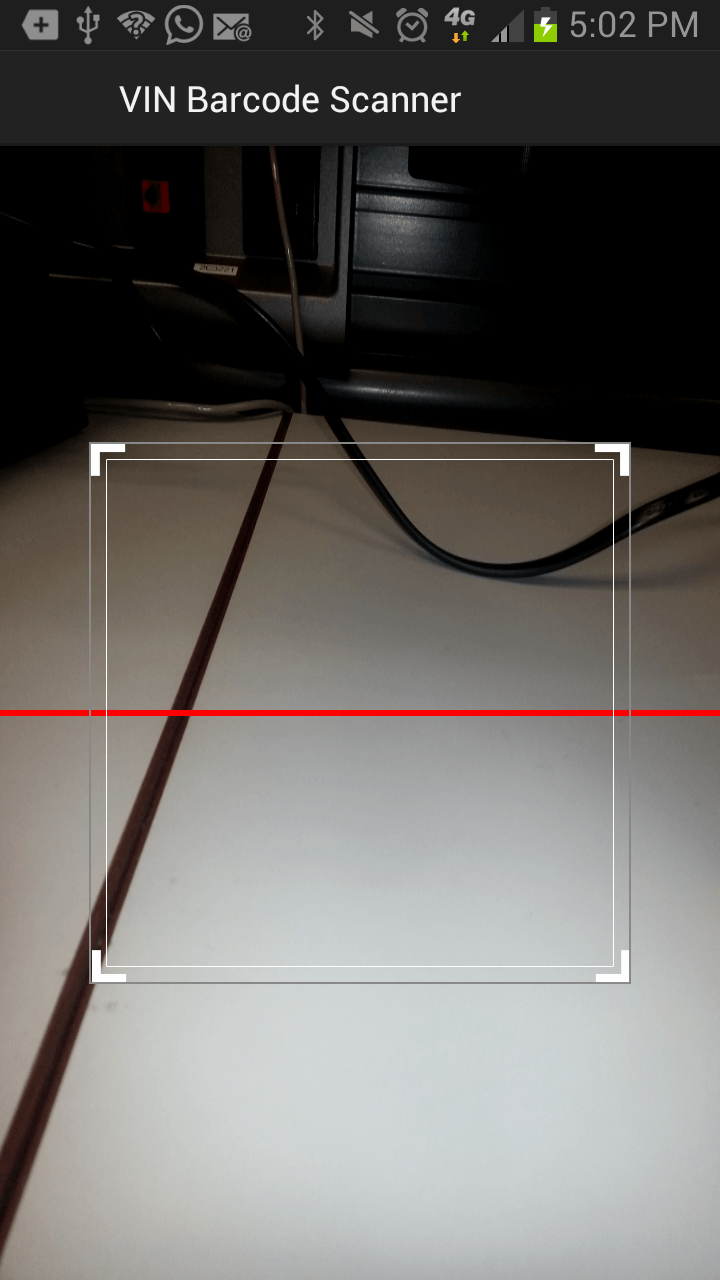
Журнал ошибок:
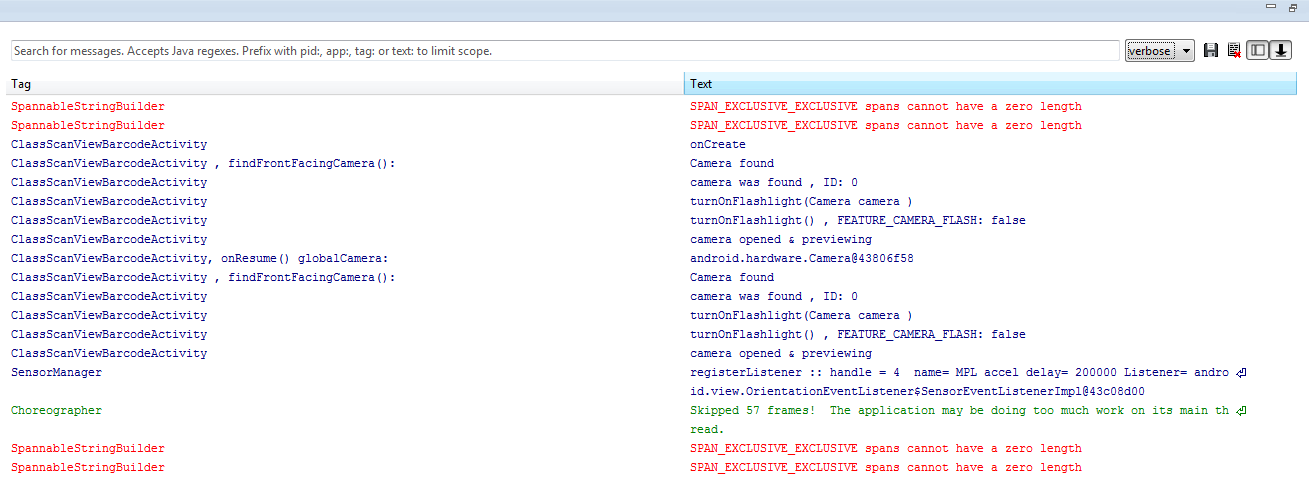
** Если инструмент Eclipse GUI показывает желаемый вид, то почему панель инструментов все еще отсутствует??? Я хотел бы иметь панель инструментов внизу, желательно используя RelativeLayout без сбоев или зависаний экрана. Любая помощь будет оценена.
Я использую Samsung Galaxy S3 для тестирования.
Спасибо.**
9 ответов
Вы хотели что-то подобное?
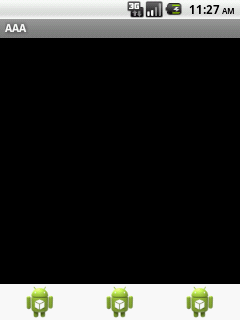
макет, который я использовал:
<?xml version="1.0" encoding="utf-8"?>
<RelativeLayout
xmlns:android="http://schemas.android.com/apk/res/android"
android:layout_width="match_parent"
android:layout_height="match_parent"
>
<LinearLayout
android:id="@+id/linearLayoutToolbar"
android:layout_width="match_parent"
android:layout_height="wrap_content"
android:layout_alignParentBottom="true"
>
<ImageView
android:id="@+id/imageView1"
android:layout_width="0dp"
android:layout_height="wrap_content"
android:layout_weight="1"
android:gravity="center"
android:src="@drawable/ic_launcher"
/>
<ImageView
android:id="@+id/imageView2"
android:layout_width="0dp"
android:layout_height="wrap_content"
android:layout_weight="1"
android:gravity="center"
android:src="@drawable/ic_launcher"
/>
<ImageView
android:id="@+id/imageView3"
android:layout_width="0dp"
android:layout_height="wrap_content"
android:layout_weight="1"
android:gravity="center"
android:src="@drawable/ic_launcher"
/>
</LinearLayout>
<SurfaceView
android:id="@+id/surfaceViewBarcodeScanner"
android:layout_width="match_parent"
android:layout_height="match_parent"
android:layout_above="@+id/linearLayoutToolbar"
/>
</RelativeLayout>
Обратите внимание, что, поскольку у меня не было ваших изображений в моей папке res / drawable, я заменил их на ic_launcher.
Также обратите внимание, что я использовал устройство ldpi под управлением Froyo (уровень API 2.2). Вот почему изображение меньше, чем у вас, и пользовательский интерфейс немного отличается (...). Во всяком случае, это работает в любом разрешении и с каждой версией ОС.
Некоторые небольшие изменения в вашей первоначальной компоновке приведут к устранению ошибки. Вам нужно использовать android:layout_height="0dp" определение 0dp поможет вашему виду поверхности уместиться на вашем экране.
<SurfaceView
android:id="@+id/surfaceViewBarcodeScanner"
android:layout_width="match_parent"
android:layout_height="0dp"
android:layout_above="@+id/linearLayoutToolbar"
/>
И я не нашел использование атрибута ниже в SurfaceView.
android:layout_gravity="top"
android:scaleType="fitXY"
Изучите этот макет, как работает android:layout_height="0dp" и как работает android:layout_width="0dp".
Попробуйте изменить макет так:
<LinearLayout xmlns:android="http://schemas.android.com/apk/res/android"
android:id="@+id/LayoutForPreview"
android:layout_width="fill_parent"
android:layout_height="fill_parent"
android:orientation="vertical"
android:screenOrientation="portrait" >
<SurfaceView
android:id="@+id/surfaceViewBarcodeScanner"
android:layout_width="match_parent"
android:layout_height="0dp"
android:layout_gravity="top"
android:scaleType="fitXY"
android:layout_weight="1" />
<LinearLayout
android:id="@+id/linearLayoutToolbar"
android:layout_width="match_parent"
android:layout_height="0dp"
android:layout_weight=".1"
android:orientation="horizontal"
android:layout_gravity="bottom" >
<ImageView
android:id="@+id/imageView1"
android:layout_width="wrap_content"
android:layout_height="wrap_content"
android:scaleType="fitXY"
android:src="@drawable/scanner_bottom_left" />
<ImageView
android:id="@+id/imageView2"
android:layout_width="wrap_content"
android:layout_height="wrap_content"
android:layout_weight="0.68"
android:scaleType="fitXY"
android:src="@drawable/scanner_bottom_center_toolbar" />
<ImageView
android:id="@+id/imageView3"
android:layout_width="wrap_content"
android:layout_height="wrap_content"
android:scaleType="fitXY"
android:src="@drawable/scanner_bottom_right_landscape_button" />
</LinearLayout>
Я вижу несколько ошибок в вашем исходном XML 1. В виде поверхности вы используете:
android:layout_above="@+id/linearLayoutToolbar"
Вы должны использовать @+id при создании Id, но когда вы хотите сделать ссылку, вы должны делать только @id следующим образом:
android:layout_above="@id/linearLayoutToolbar"
2. Вы не можете сделать ссылку на другой объект, который еще не создан! Таким образом, вы должны поместить SurfaceView ниже de linearlayout следующим образом:
<RelativeLayout xmlns:android="http://schemas.android.com/apk/res/android"
android:id="@+id/LayoutForPreview"
android:layout_width="fill_parent"
android:layout_height="fill_parent"
android:orientation="vertical"
android:screenOrientation="portrait" >
<LinearLayout
android:id="@+id/linearLayoutToolbar"
android:layout_width="match_parent"
android:layout_height="wrap_content"
android:layout_alignParentBottom="true"
android:orientation="horizontal" >
<ImageView
android:id="@+id/imageView1"
android:layout_width="wrap_content"
android:layout_height="wrap_content"
android:scaleType="fitXY"
android:src="@drawable/scanner_bottom_left" />
<ImageView
android:id="@+id/imageView2"
android:layout_width="wrap_content"
android:layout_height="wrap_content"
android:layout_weight="0.68"
android:scaleType="fitXY"
android:src="@drawable/scanner_bottom_center_toolbar" />
<ImageView
android:id="@+id/imageView3"
android:layout_width="wrap_content"
android:layout_height="wrap_content"
android:scaleType="fitXY"
android:src="@drawable/scanner_bottom_right_landscape_button" />
</LinearLayout>
<SurfaceView
android:id="@+id/surfaceViewBarcodeScanner"
android:layout_width="match_parent"
android:layout_height="wrap_content"
android:layout_above="@id/linearLayoutToolbar"
android:layout_gravity="top"
android:scaleType="fitXY" />
</RelativeLayout>
3. Вы должны добавить вес к своим 3 ImageViews следующим образом:
android:layout_weight="1"
Почему вы используете RelativeLayout в качестве корневого макета, я думаю, что гораздо проще использовать LinearLayou с параметром layout_weight в одном из дочерних представлений:
<?xml version="1.0" encoding="utf-8"?>
<LinearLayout xmlns:android="http://schemas.android.com/apk/res/android"
android:orientation="vertical"
android:layout_width="match_parent"
android:layout_height="match_parent">
<SurfaceView
android:layout_weight="1"
android:id="@+id/surfaceViewBarcodeScanner"
android:layout_width="match_parent"
android:layout_height="0dp" />
<!-- LinearLayout that contains toolbar that is divided into 3 sections horizontally -->
<LinearLayout
android:id="@+id/linearLayoutToolbar"
android:layout_width="wrap_content"
android:layout_height="wrap_content"
android:orientation="horizontal">
<ImageView
android:id="@+id/imageView1"
android:layout_width="wrap_content"
android:layout_height="wrap_content"
android:src="@drawable/scanner_bottom_left" />
<ImageView
android:id="@+id/imageView2"
android:layout_width="wrap_content"
android:layout_height="wrap_content"
android:src="@drawable/scanner_bottom_center_toolbar" />
<ImageView
android:id="@+id/imageView3"
android:layout_width="wrap_content"
android:layout_height="wrap_content"
android:src="@drawable/scanner_bottom_right_landscape_button" />
</LinearLayout>
</LinearLayout>
Вы забыли рассказать surfaceView быть above linearLayout, Ваш код должен выглядеть примерно так:
<?xml version="1.0" encoding="utf-8"?>
<RelativeLayout xmlns:android="http://schemas.android.com/apk/res/android"
android:layout_width="match_parent"
android:layout_height="match_parent" >
<LinearLayout
android:id="@+id/linearLayoutToolbar"
android:layout_width="match_parent"
android:layout_height="wrap_content"
android:layout_alignParentBottom="true" >
<ImageView
android:id="@+id/imageView1"
android:layout_width="wrap_content"
android:layout_height="wrap_content"
android:src="@drawable/scanner_bottom_left" />
<ImageView
android:id="@+id/imageView2"
android:layout_width="wrap_content"
android:layout_height="wrap_content"
android:src="@drawable/scanner_bottom_center_toolbar" />
<ImageView
android:id="@+id/imageView3"
android:layout_width="wrap_content"
android:layout_height="wrap_content"
android:src="@drawable/scanner_bottom_right_landscape_button" />
</LinearLayout>
<SurfaceView
android:id="@+id/surfaceViewBarcodeScanner"
android:layout_width="match_parent"
android:layout_height="match_parent"
android:layout_above="@+id/linearLayoutToolbar" />
</RelativeLayout>
Что вы действительно хотите, так это не использовать Relativelayout, а вместо этого использовать Linearlayout в качестве корня. Затем установите вес вида поверхности на 1, что-то вроде:
<SurfaceView
android:id="@+id/surfaceViewBarcodeScanner"
android:layout_width="match_parent"
android:layout_height="match_parent"
android:layout_weight="1"/>
<ImageView
android:id="@+id/imageView1"
android:layout_width="wrap_content"
android:layout_height="wrap_content"
android:src="@drawable/scanner_bottom_left" />
<ImageView
android:id="@+id/imageView2"
android:layout_width="wrap_content"
android:layout_height="wrap_content"
android:src="@drawable/scanner_bottom_center_toolbar" />
<ImageView
android:id="@+id/imageView3"
android:layout_width="wrap_content"
android:layout_height="wrap_content"
android:src="@drawable/scanner_bottom_right_landscape_button" />
</LinearLayout>
Добавьте это к вашему LinearLayout содержащий imageView
android:layout_alignParentBottom="true"
Я использовал такие макеты во многих приложениях, и вот как должен быть ваш макет. Никаких хитростей, никаких молитв за удачу, это просто чистый, счастливый и всегда работающий способ добиться этого.
<RelativeLayout xmlns:android="http://schemas.android.com/apk/res/android"
android:layout_width="fill_parent"
android:layout_height="fill_parent"
android:screenOrientation="portrait" >
<SurfaceView
android:id="@+id/surfaceViewBarcodeScanner"
android:layout_width="match_parent"
android:layout_height="wrap_content"
android:layout_above="@+id/linearLayoutToolbar"
android:layout_alignParentTop="true" />
<LinearLayout
xmlns:android="http://schemas.android.com/apk/res/android"
android:id="@+id/linearLayoutToolbar"
android:layout_width="match_parent"
android:layout_height="wrap_content"
android:layout_alignParentBottom="true"
android:orientation="horizontal" >
<ImageView
android:id="@+id/imageView1"
android:layout_width="wrap_content"
android:layout_height="wrap_content"
android:scaleType="fitXY"
android:src="@drawable/scanner_bottom_left" />
<ImageView
android:id="@+id/imageView2"
android:layout_width="wrap_content"
android:layout_height="wrap_content"
android:layout_weight="0.68"
android:scaleType="fitXY"
android:src="@drawable/scanner_bottom_center_toolbar" />
<ImageView
android:id="@+id/imageView3"
android:layout_width="wrap_content"
android:layout_height="wrap_content"
android:scaleType="fitXY"
android:src="@drawable/scanner_bottom_right_landscape_button" />
</LinearLayout>
</RelativeLayout>
здесь у вас есть предварительный просмотр одного из моих приложений.
Размещенный код адаптирован к вашему, поэтому копирование / вставка сделает это. обратите внимание, что все в простом файле, поэтому вы должны немного изменить свою деятельность